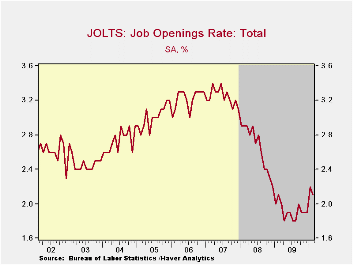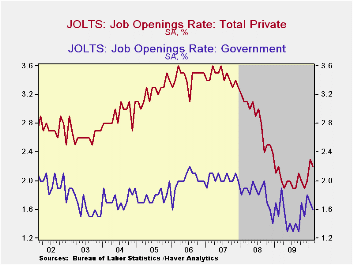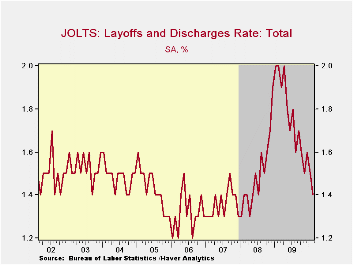 Global| Apr 07 2010
Global| Apr 07 2010JOLTS: U.S. Job Openings Slip
by:Tom Moeller
|in:Economy in Brief
Summary
The Bureau of Labor Statistics reported yesterday that the rate of improvement in job market conditions eased in February. The latest Job Openings & Labor Turnover Survey (JOLTS) indicated that the job openings rate slipped to 2.1% [...]

The Bureau of Labor Statistics reported yesterday that the rate of improvement in job market conditions eased in February. The latest Job Openings & Labor Turnover Survey (JOLTS) indicated that the job openings rate slipped to 2.1% from an upwardly revised 2.2% in January. Nevertheless the rate was near the highest in roughly one year. The job openings rate is the number of job openings on the last business day of the month as a percent of total employment plus job openings. Job availability fell 4.6% and retraced nearly half of its upwardly revised January increase. It remained off 3.8% year-to-year. Last year job availability fell 17.8% following a 29.7% decline during 2008. The series dates back to December 2000.
The government sector led the latest decline in the job openings rate. It fell to the lowest level since November after several months of improvement. A slip in the private sector rate reflected fewer professional, education & health services jobs but factory and retail jobs grew strongly.
The hires rate has been stable near 3.1% since the end of 2008.The hires rate is the number of hires during the month divided by employment.The actual number of hires reversed all of the January increase (-3.3% y/y) but the rate of decline has moderated substantially since the recession.
The job separations rate eased to a new series' low of 3.1% with the actual number of separations off 18.7% year-to-year. The layoff rate alone fell to a nineteen-month low of 1.4%. Separations include quits, layoffs, discharges, and other separations as well as retirements. The layoff rate alone fell to 1.4% from 2.0% twelve months earlier.
The JOLTS survey dates only to December 2000 but has followed the movement in nonfarm payrolls, though the actual correlation between the two series is low.


| JOLTS (Job Openings & Labor Turnover Survey) | February | January | December | Feb. '09 | 2009 | 2008 | 2007 |
|---|---|---|---|---|---|---|---|
| Job Openings, Total | |||||||
| Rate (%) | 2.1 | 2.2 | 1.9 | 2.1 | 1.9 | 2.2 | 3.1 |
| Total (000s) | 2,723 | 2,854 | 2,531 | 2,830 | 2,531 | 3,078 | 4,378 |
| Hires, Total | |||||||
| Rate (%) | 3.1 | 3.2 | 3.1 | 3.1 | 37.3 | 41.1 | 45.9 |
| Total (000s) | 3,961 | 4,087 | 3,997 | 4,095 | 48,649 | 56,082 | 63,234 |
| Layoffs & Discharges, Total | |||||||
| Rate (%) | 1.4 | 1.5 | 1.6 | 2.0 | 20.7 | 17.7 | 16.5 |
| Total (000s) | 1,822 | 1,953 | 2,049 | 2,593 | 27,683 | 24,589 | 22,606 |
Tom Moeller
AuthorMore in Author Profile »Prior to joining Haver Analytics in 2000, Mr. Moeller worked as the Economist at Chancellor Capital Management from 1985 to 1999. There, he developed comprehensive economic forecasts and interpreted economic data for equity and fixed income portfolio managers. Also at Chancellor, Mr. Moeller worked as an equity analyst and was responsible for researching and rating companies in the economically sensitive automobile and housing industries for investment in Chancellor’s equity portfolio. Prior to joining Chancellor, Mr. Moeller was an Economist at Citibank from 1979 to 1984. He also analyzed pricing behavior in the metals industry for the Council on Wage and Price Stability in Washington, D.C. In 1999, Mr. Moeller received the award for most accurate forecast from the Forecasters' Club of New York. From 1990 to 1992 he was President of the New York Association for Business Economists. Mr. Moeller earned an M.B.A. in Finance from Fordham University, where he graduated in 1987. He holds a Bachelor of Arts in Economics from George Washington University.






